Basic Information on the Pentax K mount:
The Pentax K mount is the oldest still current SLR/dSLR lens mount. Since its introduction in 1975 it has been extended and modified several times to stay current.
With 50 years under its belt, the Pentax K mount is – without a doubt – among the most venerable lens mounts and has only one contender for that title: the Nikon F mount. The exceptional longevity of these two mounts is based on that Pentax and Nikon were alone in successfully implementing a transition to AF lenses within the confines of the same lens mount (Minolta and Canon infamously orphaned their existing user base by switching to an incompatible mount) 1.
However, for a lens mount introduced in 1975 to remain relevant, that mount has had to accommodate some rather significant modifications. This article covers the mount and its key versions.
Note please: The development trajectory of the Pentax K mount is more complicated than with any other mount and it has 8–11 versions (depending on how you count). Hence, this article will be rather long…
Pentax K mount specifications
Mount type: Bayonet (lens release on body)
Flange focal distance: 45,46 mm
Film format: 36mm x 24mm (‘Full frame’)
Mount communication: It’s complicated. See table below for details.
History of the Pentax K mount
The Asahi Pentax company was – more than most – instrumental in the early development and success of the Pentaprism SLR. Compared to many of its Japanese competitors (Canon, Minolta, Nikon, Olympus) Asahi Pentax did not start by developing a proprietary mount, and instead used the M42 lens mount.
However, Asahi Pentax was not entirely happy with the camera <==> lens communication allowed for by a vanilla M42 auto mount. As Pentax’ main competitors (at least some of those that had their proprietary lens mounts) were able to implement through-the-lens metering without having to resort to stop-down metering, Pentax started in the late 1960s implementing their own modifications to the M42 mount to allow for open aperture metering (see the JAPB article on the M42 mount, especially the Pentax variant).
However, by the early 1970s, it was obvious to the buchō at Asahi Pentax that the M42 mount had become a burden rather than an asset. In a step intended to increase Pentax’ future potential and control over its destiny, Pentax in 1975 introduced the Pentax K mount.
Interestingly, the original Pentax K mount of 1975 did very much the same as Pentax’ proprietary variant of the M42 mount did: it allowed the camera to stop down the lens to the aperture value selected on the lens while allowing the lens to communicate the selected aperture value to the camera (using a very similar if incompatible approach). Moreover, the flange focal distance of the Pentax K mount was clearly designed to allow for a degree of compatibility with earlier M42 lenses. What the Pentax K mount of 1975 lacked were any of those systems for camera <==> lens communication that shutter priority or program auto would have necessitated. The table was set for the next generation of the Pentax K mount.
Evolution of the Pentax K mount
That lens mounts need to evolve to keep up with the demands (and abilities) of new technologies is nothing new. However in most cases these development trajectories are relatively linear. Hence for instance the original Minolta SR mount evolved into the Minolta SR(MC) mount which in turn evolved into the Minolta SR(MD) mount.
In the case of the Pentax K mount, the development has not been strictly linear, nor has a newer lens mount variant necessarily supplanted the previous as often Pentax has been offering lenses for several variants of the mount at the same time 2. That said, the general trajectory of the Pentax K mount can best be summed up in the timeline below:

Not surprisingly, considering the multitude of demands placed on a lens mount over a span of almost half a century of active innovation, Pentax’s dedication to the K-mount has lead to some solutions having been adopted, that clearly show an incremental nature. For the reader to get the best possible picture, we will follow this timeline step by step.
1975 – Pentax K
As mentioned: The Pentax K mount of 1975 was a rather typical bayonet mount that allowed the same level of camera <==> lens communication as Pentax’ proprietary extension of the M42 mount. One lever [3] would stop down the lens to whatever value had been selected on the aperture ring, while another lever [4] would indicate the selected aperture to the camera body.
The original series of Pentax K cameras and bodies were geared towards Aperture priority auto exposure as well as manual exposure (on select camera bodies).

Key characteristics of the Pentax K –mount:
[1] Three-pronged bayonet mount, four edges tapered (two straight)
[2] Locking groove at roughly 03:45 o’clock
[3] Stop-down lever
[4] Aperture indicator3 lever
1981 – Pentax KF
The Pentax KF mount was introduced in 1981 together with the Pentax ME F camera – Pentax’ first attempt at constructing a functional autofocus system. The Pentax ME F’s autofocus system was based on combining a body that would judge whether the image was in focus and would send electronic signals to the lens; with a lens that has an autofocus motor and a power source (AA batteries) and would refocus at the body’s behest.
The Pentax ME F quickly turned out to be both an immature technology and too much of a stretch goal for Pentax4, so only one camera and only one lens was ever produced.
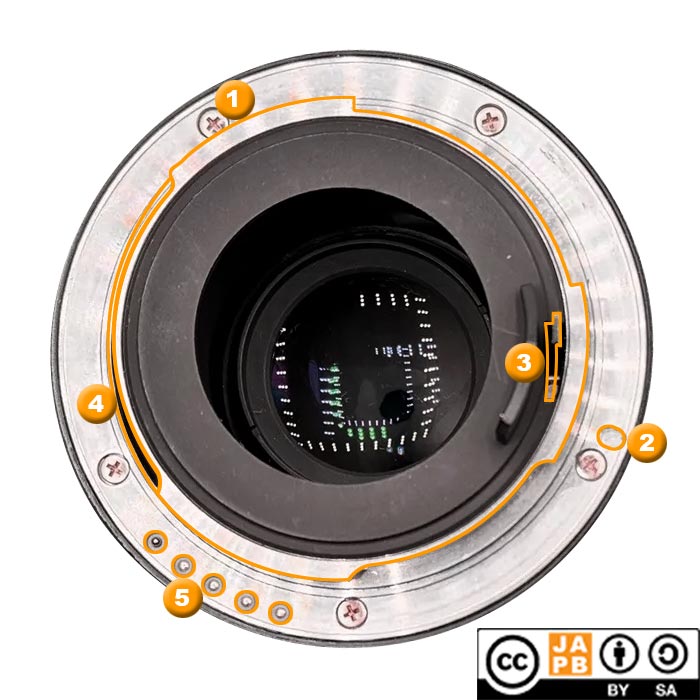
Key characteristics of the Pentax KF –mount:
[1] Three-pronged bayonet mount, four edges tapered (two straight)
[2] Locking groove at roughly 03:45 o’clock
[3] Stop-down lever
[4] Aperture indicator lever
[5] Five electronic contacts for operating autofocus
The role of the electronic contacts (left to right):
• Used for activating the camera’s light meter and focus detector (after the photographer had pressed a focus activation button on the lens)
• Unused5
• Focus toward infinity
• Focus toward MFD
• Unused
1983 – Pentax KA
The early 1980s saw the advent of program auto exposure while camera manufacturers scrambled to extend their lens mounts to include the necessary functionality. This was especially a pressing consideration for all those manufacturers that to date had emphasised aperture priority over shutter priority auto exposure (like Minolta, Nikon, Olympus and Pentax).
The key requirements for program auto to work are a) the camera body must know the lens’ maximum aperture and minimum aperture; b) the lens aperture ring must have a position where the camera can take control of the working aperture; c) the camera must be able to stop down a lens precisely.
Pentax implemented these requirements in the KA variant of the Pentax K mount
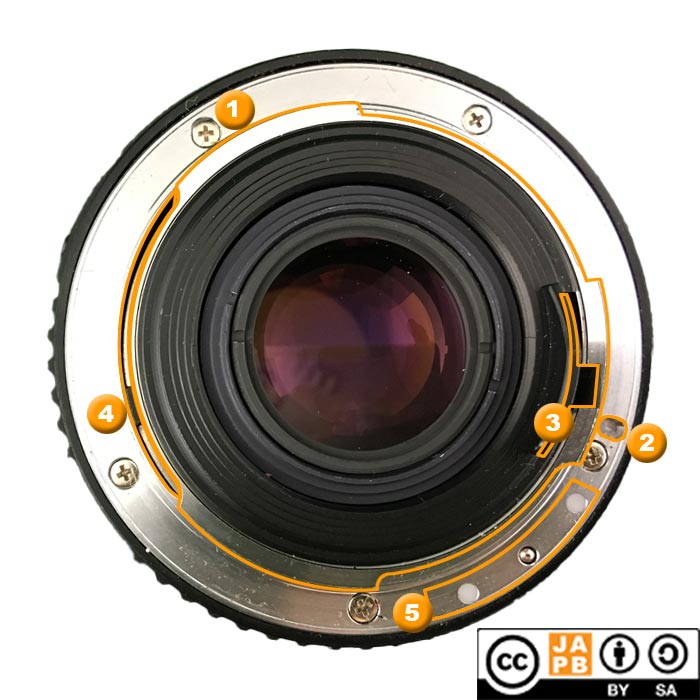
Key characteristics of the Pentax KA –mount:
[1] Three-pronged bayonet mount, four edges tapered (two straight)
[2] Locking groove at roughly 03:45 o’clock
[3] Stop-down lever (same placement as with earlier lenses, but this lever was calibrated so that the camera could stop down the lens to a precise aperture value)
[4] Aperture indicator lever
[5] Six ‘electronic’ contacts
To be honest, calling the contacts of the KA mount ‘electronic’ maybe raises too high expectations. In reality these were mostly about coding the lens’ aperture range through a series of conducting and non-conducting contact areas, with an added pin (indicated with *) to communicate whether the lens’ aperture ring had be set to ‘auto’ or not.
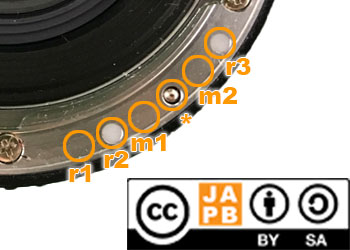
The system used for coding a lens’ aperture range was based on whether the electronic contact on the camera body’s side would encounter a conductive area (like the lens mount’s metal) or a small plastic (non-conductive) patch.
In this the contact areas named m1 and m2 would encode the lens’ minimum aperture and r1, r2, and r36 would encode the width of the lens’ aperture range in stops.
| m1 | m2 | minimum aperture |
|---|---|---|
| 0 | 0 | f/16 |
| 0 | 1 | f/32 |
| 1 | 0 | f/45 |
| 1 | 1 | f/22 |
| r1 | r2 | r3 | aperture range width |
|---|---|---|---|
| 0 | 0 | 0 | 5 stops |
| 0 | 0 | 1 | 5 and a half stops |
| 0 | 1 | 0 | 6 stops |
| 0 | 1 | 1 | 6 and a half stops |
| 1 | 0 | 0 | 7 stops |
| 1 | 0 | 1 | 7 and a half stops |
| 1 | 1 | 0 | 8 stops |
| 1 | 1 | 1 | 8 and a half stops |
Taken together these two component sets (r1, r2, m1, *, m2, r3) result in the following table of potential codes (not all permutations were used as no Pentax KA lenses had apertures larger than f/1.2 or minimum apertures larger than f/22).
| Aperture range | f/16 | f/22 | f/32 | f/45 |
|---|---|---|---|---|
| – | 110*01 | |||
| – | 110*00 | |||
| f/1.2 | 100*00 | 111*11 | ||
| f/1.4 | 010*01 | 111*10 | ||
| f/1.7 | 010*00 | 101*11 | 110*11 | |
| f/2 | 000*01 | 101*10 | 110*10 | |
| f/2.5 | 000*00 | 011*11 | 100*11 | 111*01 |
| f/2.8 | 011*10 | 100*10 | 111*00 | |
| f/3.5 | 001*11 | 010*11 | 101*01 | |
| f/4 | 001*10 | 010*10 | 101*00 | |
| f/4.5 | 000*11 | 011*01 | ||
| f/5.6 | 000*10 | 011*00 | ||
| f/6.7 | 001*01 | |||
| f/8 | 001*00 |
The lens mount pictured above (101*10) is of a Pentax-A 50 mm f/2 lens (minimum aperture f/22).
1987 – Pentax KAF
Minolta Launched the Dynax/Maxxum/Alpha 7000 autofocus camera in 1985, followed by the Nikon F-501 and Olympus OM-707 in 1986. Clearly the technology had matured enough since Pentax’ earlier 1981 attempt, that autofocus cameras and lenses now seemed altogether more viable. As a result, also Pentax returned to the fray.
Alike the solution pioneered by Minolta (and also adopted by Nikon and Olympus) Pentax’ second attempt at autofocus placed all the focusing optics & electronics into the camera body, including a motor that would drive the focusing gears within the lens through a mechanical coupling (a slot-drive screw). The result of this was a series of autofocus cameras (starting with the Pentax SFX7), a new lens mount (referred to as the Pentax KAF mount and a new series of lenses (referred to as SMC-F)
In the end, the introduction of this autofocus mount necessitated relatively modest changes to the existing Pentax KA mount. Besides the driveshaft for the focusing mechanism, one more electronic contact was added (the function of all the others stayed the same).
KAF mount lenses are still (2025) being produced and sold new.
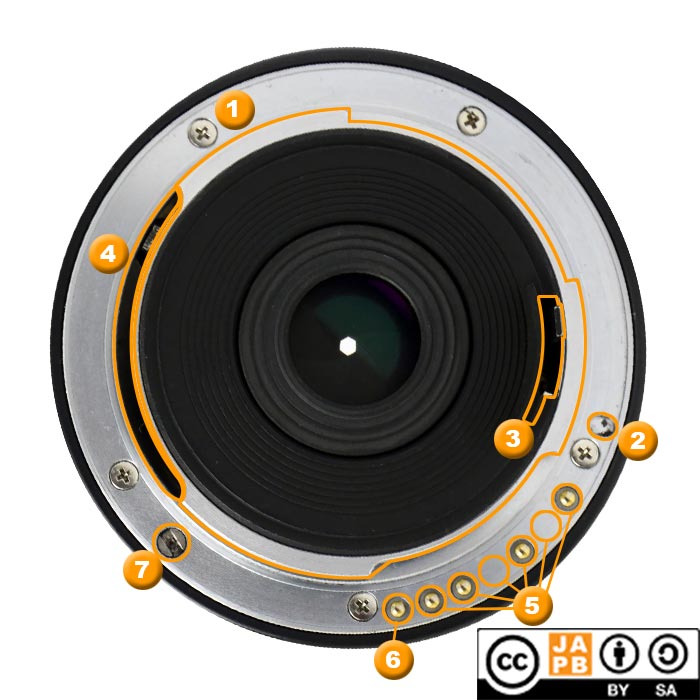
Key characteristics of the Pentax KAF –mount:
[1] Three-pronged bayonet mount, four edges tapered (two straight)
[2] Locking groove at roughly 03:45 o’clock
[3] Stop-down lever (calibrated)
[4] Aperture indicator lever
[5] Six ‘electronic’ contacts
[6] one more contact for communicating various information (focal length, focusing distance, exact selected aperture, physical size of lens8)
[7] Slot-drive screw for body-driven autofocus.
Of these the first 5 characteristics are identical to the preceding KA mount both in form and function, and the only changes are the seventh electronic contact and the slot-drive shaft.
Side note: In the late 2000s Pentax started using the KAF mount as basis for some of its budget lenses. These lenses are otherwise similar except:
• They use a plastic mount
• They do not have an aperture ring, so the aperture indicator is always in the ‘A’ position
• Because of the plastic (non-conductive) mount, one of the electronic contacts has a significantly different shape.
This means that the KAF mount also comes in a cosmetically significantly different guise (see below)
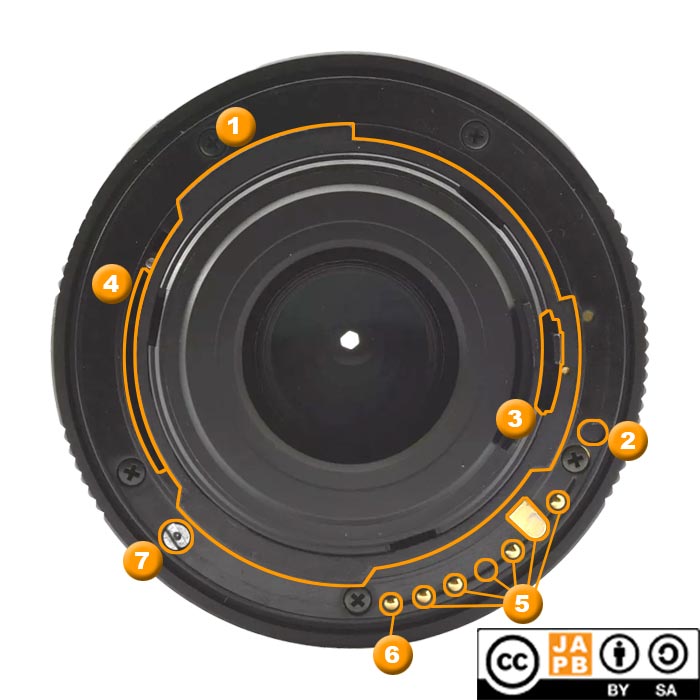
Key characteristics of the Pentax KAF –mount (plastic version):
[1] Three-pronged bayonet mount, four edges tapered (two straight)
[2] Locking groove at roughly 03:45 o’clock
[3] Stop-down lever (same as KA lenses)
[4] Aperture indicator lever (unless the lens has an aperture ring, the indicator is forever set to ‘A’)
[5] Six ‘electronic’ contacts, one of which has a different shape (compared to vanilla KAF)
[6] A seventh contact for communicating various information (as with vanilla KAF)
[7] Slot-drive screw for body-driven autofocus (as with vanilla KAF)
1991 – Pentax KAF2
In 1991 two of the most prominent Japanese camera companies – Minolta and Pentax – both introduced new flagship cameras that not only offered autofocus, but also offered power zoom. The key concept of power zoom was to enable photographers to control the field-of-view by pushing buttons on the camera, instead of having to physically rotate or push/pull the zoom ring of the lens. The concept of power zoom SLR can be seen as a step towards making SLRs more like compact cameras (that already had power zooms) but on the other hand (pun intended) it was a logical move.
Traditionally photographers would be known for gripping the camera in their right hand and the lens in their left hand, with the left hand being responsible for aperture, focus and zoom. As exposure automation and autofocus had already taken care of 2/3 of the tasks of the left hand, power zoom promised to liberate the left hand entirely.
To facilitate power zooming, Pentax added two more electronic contacts to the earlier KAF mount and the result is commonly known as the KAF2 mount. Even though power zoom quickly turned out to not be what the audience wanted9, Pentax later repurposed these electronic contacts for powering in-lens focusing motors.
KAF2 mount lenses are still (2025) being produced and sold new.
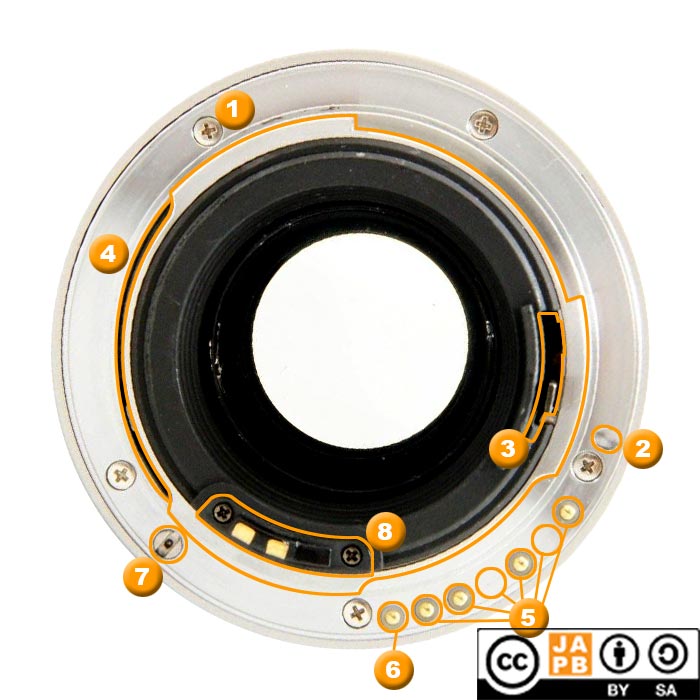
Key characteristics of the Pentax KAF2 –mount:
[1] Three-pronged bayonet mount, four edges tapered (two straight)
[2] Locking groove at roughly 03:45 o’clock
[3] Stop-down lever (calibrated)
[4] Aperture indicator lever
[5] Six ‘electronic’ contacts
[6] A seventh contact for communicating various information. Compared to the KAF mount, the KAF2 version also communicates MTF information, hence informing the body of (in terms of sharpness) optimal aperture ranges.
[7] Slot-drive screw for body-driven autofocus.
[8] Two added contacts that were initially used for power zooming and later found a new role in feeding power to internal focus motors.
To be clear: the only difference between a KAF and KAF2 mounts are the two added contacts [8]. Even so, the practical differences between KAF and KAF2 lenses can be quite remarkable as KAF2 lenses do not depend on the body’s focusing motor for autofocus. Regarding the pros and cons of various approaches to facilitating autofocus, please see the JAPB article on autofocus (as a technology)
1997 – Pentax KA2
In 1997 Pentax introduced the MZ-M camera body (ZX-M in some markets), which was an otherwise thoroughly modern SLR camera, except it did not support auto focus. That camera implemented the entire KAF mount, but without the autofocus drive shaft. Even though it was introduced after the KAF2 mount it also did not have the power zoom contacts. It however differs from the KA mount by that it does have the seventh electronic contact introduced together with the KAF mount.
The Pentax KA2 variant is a bit of an odd case, as Pentax never manufactured any lenses for it (but third party manufacturers might have – if you have such a lens, feel free to share). Hence also the picture below is a mock-up of what the mount of a KA2 lens would have looked like (in terms of mount elements):

Key characteristics of the Pentax KA2 –mount:
[1] Three-pronged bayonet mount, four edges tapered (two straight)
[2] Locking groove at roughly 03:45 o’clock
[3] Stop-down lever
[4] Aperture indicator lever
[5] Six ‘electronic’ contacts
[6] A seventh contact for communicating various information (as with vanilla KAF)
[7] NO Slot-drive screw.
2007 – Pentax KAF3
Pentax discontinued its lineup of film SLRs in 2006. Thereafter Pentax only offered digital SLRs. After having introduced its first digital SLRs in 2003, by 2007 Pentax’ transition to digital was in full swing.
However, it seems clear that Pentax initially was not sure which of its legacy features those new digital bodies should support. For instance the initial digital SLR (the *ist D) did support slot-drive autofocus, did not have the power zoom contacts (and was in that sense on the level of the KAF mount) but was not able to read the indicated aperture of the lens, hence – in practice – only supporting lenses that could (and would) be set in auto aperture mode. (this is sometimes referred to as the ‘crippled’ KAF mount). In terms of lenses this meant that the *ist D would work with any lenses that either entirely lacked an aperture ring or had an aperture ring that could (and would) be set in “A”. In practice, this excluded Pentax K mount lenses but supported KA mount (and later) lenses.
Subsequent versions of Pentax dSLRs did not bring clarity to the situation, instead it was clear that Pentax would in a step-by-step fashion drop features that were deemed to be relevant only in terms of remaining backwards compatibility. While (in terms of dSLR bodies) the situation is somewhat complex, in terms of lenses it is rather more simple. In 2007 Pentax started offering lenses that were (otherwise) identical to KAF2 lenses, but they no longer offered a slot drive screw. Instead they used the electronic contacts that were (originally) developed for power zooming to drive focus motors that were integrated to the lenses. This standard has subsequently been called the KAF3 mount. In practical terms the KAF3 mount also cemented the trend that had started earlier, meaning that lenses would no longer have aperture control rings, and that the aperture indicator would be fixed in the ‘A’ position.
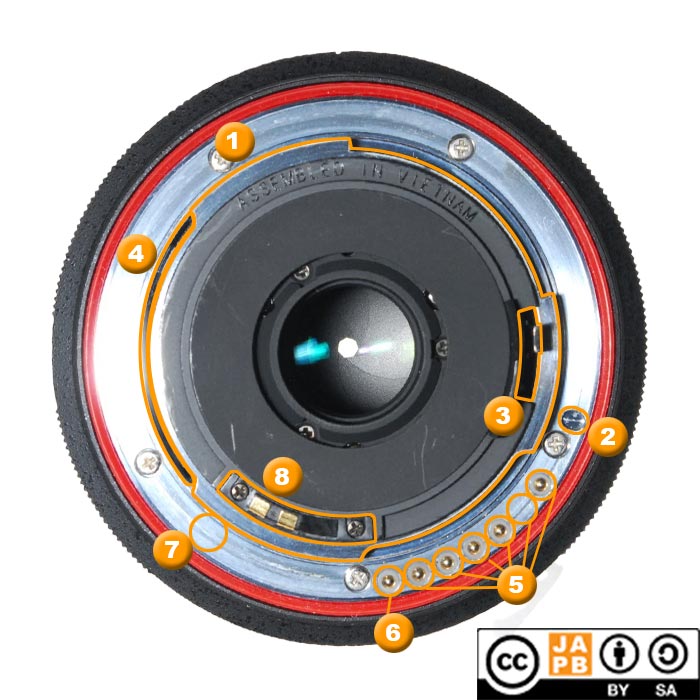
Key characteristics of the Pentax KAF3 –mount:
[1] Three-pronged bayonet mount, four edges tapered (two straight)
[2] Locking groove at roughly 03:45 o’clock
[3] Stop-down lever
[4] Aperture indicator lever (always stuck in ‘A’ position)
[5] Six ‘electronic’ contacts
[6] A seventh contact for communicating various information (as with vanilla KAF)
[7] NO Slot-drive screw.
[8] Two electronic contacts for in-lens zoom motors.
2016 – Pentax KAF4
In 2016 Pentax introduced the KAF4 mount which did away with all mechanical camera<==>lens connections including aperture stop-down. KAF4 lenses can only be used on Pentax dSLRs introduced after 2014. However – to date – all those dSLRs introduced after 2014 also support other lenses (KAF3 and mostly also KAF2).
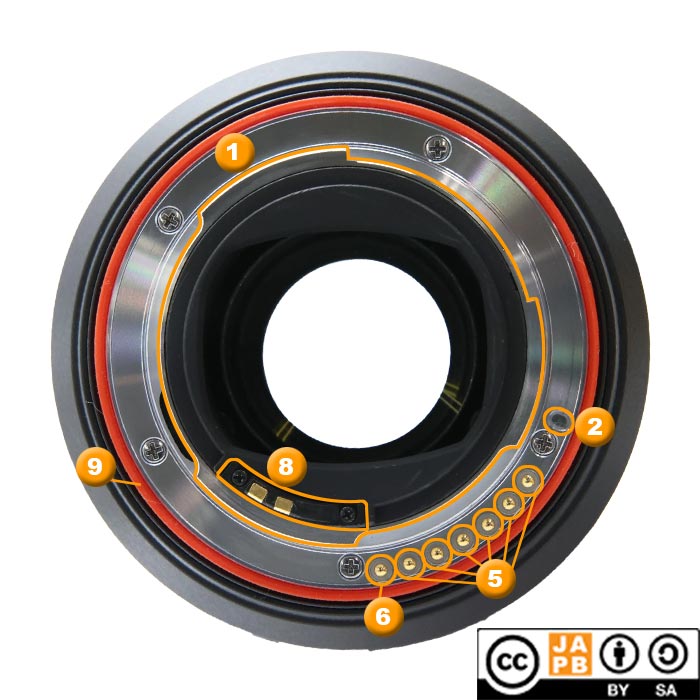
Key characteristics of the Pentax KAF4 –mount:
[1] Three-pronged bayonet mount, four edges tapered (two straight)
[2] Locking groove at roughly 03:45 o’clock
[5] Six ‘electronic’ contacts
[6] A seventh contact for communicating various information (as with vanilla KAF)
[8] Two electronic contacts for in-lens zoom motors.
[9] Weather sealing gasket (red on some lenses, black on others).
Non-Pentax Pentax K lenses
The Pentax K mount has been very popular and has gained the attention of a very broad range of lens manufacturers. Not only have Pentax K lenses been made by the ‘usual suspects’ (lens companies manufacturing lenses for all relevant mounts) but there have also been lens makers who have had a special emphasis on the Pentax K mount, because …
A striking feature of the Pentax K mount is that Pentax initially opened the Pentax K mount for other companies to use. Hence it was not only Pentax that manufactured Pentax K mount cameras but also other important camera makers such as Chinon, Cosina and Ricoh10. As some of these manufacturers went on to sell their cameras to various rebranders, Pentax K mount camera bodies can be found sporting a wide range of brands (including Carena, Exakta, Miranda, Sears …)
However, after the launch of the Pentax KA mount, Pentax decided that it would only share the original K mount (and not the KA mount). As a result some of the mount’s original users shifted to another mount, some limited themselves to the original K-spec, with some again deciding to extend the Pentax K mount in their own way to achieve the same functionality as the KA mount offered.
The K-R mount
The most prominent of these non-Pentax extension was done by Ricoh who decided to implement largely the same functionality as achieved by the KA mount, using a single spring-loaded electronic contact. This mount is typically referred to as the K-R variant although it is sometimes also referred to as the KP mount (because these Ricoh lenses were always named ‘RIKENON P’), or just simply ‘Pentax K with Ricoh Pin’. What makes the Ricoh version somewhat notorious is that when Pentax later decided where they wanted to place the slot-drive screw, it would interact with the Ricoh Pin of a Ricoh lens , leading to that the Ricoh pin would get jammed in the slot-drive screw. This in turn risked resulting in lenses that were stuck on cameras.
Because Ricoh would subsequently end their camera production11 a lot of Ricoh lenses ended up having their Ricoh pin removed so that the lenses could have a continued existence on Pentax SLRs and dSLRs.
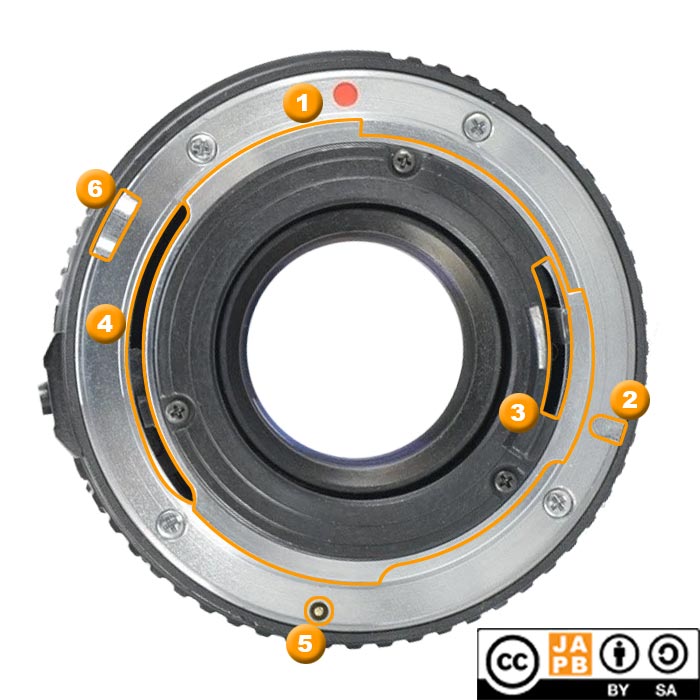
Key characteristics of the Ricoh K-R mount:
[1] Three-pronged bayonet mount, four edges tapered (two straight)
[2] Locking groove at roughly 03:45 o’clock
[3] Stop-down lever
[4] Aperture indicator lever
[5] ‘Ricoh Pin’ for communicating about the lens’ aperture range.
[6] Cutout12
A summary of ≈50 years of the Pentax K mount
A development of the Pentax K mount is repeated below. This summary focuses on identifying features, differences and what you need to consider in order to adapt a Pentax K lens to other mounts.
| Mount | Year | Comments | Features | Mount characteristics | Adaptability |
| K | 1975 | The original Pentax K | • Exposure: Av and M • Manual focus | • Two levers (aperture stop-down and aperture indicator) | MF: Problem-free |
| KF | 1981 | First autofocus mount. Quickly abandoned. | • Exposure: Av and M • Autofocus (one specific lens on one body) | • Two levers (aperture stop-down and aperture indicator) • 5 electronic contacts for operating AF | MF: Possible AF: Not available |
| KA | 1983 | Pentax K with electronic contacts for communication re: aperture range characteristics | • Exposure: Av, Tv, P, M • Manual Focus | • Two levers (aperture stop-down and aperture indicator) • 1–6 electronic contacts for communicating about aperture range. | MF: Problem-free |
| K-R (Ricoh) | 1984 | Pentax K with an electronic contact to communicate aperture range characteristics. Used only by Ricoh. | • Exposure: Av, Tv, P, M • Manual Focus | • Two levers (aperture stop-down and aperture indicator) • 1 electronic contact for communicating about aperture range. | MF: Problem-free |
| KAF | 1989 | First Pentax mainstream autofocus mount. KA functionality extended with: – autofocus facilitated by a drive shaft (slot-drive). – lens information through electronic contact. | • Exposure: Av, Tv, P, M • Auto-focus on compatible bodies • Lens info transmitted | • Two levers (aperture stop-down and aperture indicator) • 1–6 electronic contacts for communicating about aperture range. • 1 electronic contact to transmit lens info. • Slot-drive screw for AF | MF: Problem-free AF: Only with special adapter on limited systems 4 |
| KAF2 | 1991 | Two more electronic contacts added that enable lens-based autofocus. Originally these contacts were intended to enable power zoom. | • Exposure: Av, TV, P, M • Autofocus either with slot-drive or based on lens-internal motor • Lens info transmitted | • Two levers (aperture stop-down and aperture indicator) • 1–6+1 electronic contacts for communicating about aperture range. • 1 electronic contact to transmit lens info. • 2 electronic contacts to power AF. • Slot-drive screw for AF | MF: Problem-free AF: Only with special adapter on limited systems 4 |
| KA2 | 1997 | Like KAF2, but without AF drive shaft and without power contacts. Used by some third-party lenses and a manual-focus body. | • Exposure: Av, TV, P, M • No autofocus • Lens info transmitted | • Two levers (aperture stop-down and aperture indicator) • 1–6+1 electronic contacts for communicating about aperture range. • 1 electronic contact to transmit lens info. | MF: Problem-free |
| KAF3 | 2007 | Like KAF2, but without AF drive shaft | • Exposure: Av, TV, P, M • Autofocus based on lens-internal motor • Lens info transmitted | • Two levers (aperture stop-down and aperture indicator) • 1–6+1 electronic contacts for communicating about aperture range. • 1 electronic contact to transmit lens info. • 2 electronic contacts to power AF. | MF: Problem-free AF: Only with special adapter on limited systems 4 |
| KAF4 | 2016 | Like KAF3, but without aperture stop-down lever (electronic aperture) | • Exposure: Av, TV, P, M • Autofocus based on lens-internal motor • Lens info transmitted | • One lever (aperture indicator) • 1–6+1 electronic contacts for communicating about aperture range. • 1 electronic contact to transmit lens info. • 2 electronic contacts to power AF. | MF & AF: Only with special adapter on limited systems 4 |
Cross-compatibility of the Pentax K mount’s versions.
So can you take any Pentax lens for the Pentax K mount and attach it to any Pentax K mount camera? Yes and no, because there are two stories here.
Yes, You can go and buy Pentax’s newest flagship dSLR in 2025, attach any 1975 SMC Pentax lens, and the lens will function and allow you to take pictures. That is – strictly speaking – something no other current dSLR system can do 13. As long as we’re speaking about premium lenses and flagship camera bodies, the general rule of the Pentax K mount is “you can always use older lenses on newer bodies”.
Similarly, there is a very high likelihood that you can take any of Pentax’ early (pre-AF) camera bodies or any of the bodies manufactured by Chinon, Cosina, Ricoh or Zenit and mount any Pentax K lens that has a physical aperture ring on it, and go and snap pictures.
However, there have been reports that not all third party lenses will mount on all Pentax K cameras and vice versa, and the issue typically is related to the shape and size of the ‘guard fin’ protecting the stop-down lever.

Another limitation on compatibility is that starting in the late 1990s, Pentax went in for some rather aggressive cost-cutting. One of the areas where savings were sought was in no longer maintaining perfect compatibility in the budget-conscious segment. This lead to the introduction of camera bodies that could not support the earliest (K-type) lenses and lenses that lacked aperture rings and could not be used on the earlier camera bodies. Somewhat problematically, Pentax has subsequently somewhat increased the level of intentional incompatibility, resulting in that even the flagship dSLR will not be able to use a 1975 lens and read it’s selected aperture (meaning that the lens that was intended for aperture priority autoexposure becomes a Manual exposure lens).
Adapting Pentax K lenses
… to Pentax K dSLRs
First off, Because Ricoh is still (2025) manufacturing and selling Pentax K mount dSLRs (both APS-C and full frame), one alternative is to use Pentax K lenses on a modern Pentax K dSLR. In this there are however some potential incompatibilities:
• Pentax K (original 1975) lenses work only in stop-down metering, meaning that only M and Av exposure modes are at all possible.
• Pentax KF (1981 autofocus) lenses work only in stop-down metering, meaning that only M and Av exposure modes are at all possible. Furthermore, autofocus will not work.
• Pentax KA lenses work on all Pentax dSLRs, albeit only with manual focus. All metering modes that the camera supports (up to M, TAv, Av, Tv, Sv, P) work.
• Pentax KAF and KAF2 lenses work on all Pentax dSLRs, and with auto focus. All metering modes that the camera supports (up to M, TAv, Av, Tv, Sv, P) work without issues. APS-C lenses on full frame bodies work in crop mode.
• Pentax KAF3 lenses depend on which Pentax dSLR body.
• On the *ist D series and on the K100D and K 110D, these lenses work only in manual focus mode (which means that the KAF3 lenses that focus by wire do not work at all). Even then metering (M, AV, Tv, P) works.
• On all other (as of 202514) Pentax dSLRS KAF3 lenses work without issues, will auto focus and will support all the metering modes that the camera supports. APS-C lenses on full frame bodies work in crop mode.
• Pentax KAF4 lenses similarly depend on which Pentax dSLR body, but the list of supported bodies is shorter. Because Pentax KAF4 lenses depend on electronic aperture control, bodies that do not support electronic aperture will not be able to stop down these lenses, only those bodies with explicit support for KAF4 lenses15 will be able to make use of these. APS-C lenses on full frame bodies work in crop mode.
… to other brand dSLRs
Assuming that the lens has an aperture ring that allows the photographer to set the aperture, and assuming that the lens has a manual focusing ring, it is theoretically possible to find an adapter that will allow you to make use of a Pentax K lens on your dSLR. Adapting with a simple ring (basically a dumb adapter) is possible to mounts that have a sufficiently shorter flange focus distance than the Pentax K mount (45,46 mm). Thus, e.g. using Pentax K lenses on Canon EF is relatively unproblematic. If the difference in flange focus distances is not sufficient for an adapter ring (such as is the case e.g. with the Nikon-F mount), one will have to use an adapter with optics. I am currently not aware of a Pentax-K to dSLR adapter that would allow for autofocusing any Pentax-K lenses.
… to a mirrorless camera.
As long as the Pentax K lens has a manual aperture ring and a manual focus ring, you will be able to find a dumb adapter that will allow you to make good use of the lens. On the other hand, if the mirrorless system uses a smaller-than full frame sensor, a focal reducer might be useful. But assuming one is adapting to a full-frame mirrorless system (or feels no need for a focal reducer) all Pentax-K lenses up to KAF3 that have an aperture ring work flawlessly as manual focus lenses. Moreover, should one wish for autofocus, or need an adapter that allows aperture control, there are specialised adapters16 even for that (with the exception of the KF mount).
Footnotes:
- … while Olympus and Yashica bungled their respective transitions to autofocus so badly that it threatened the very viability of the company. ↩︎
- As of this article’s writing (June 2025) Pentax is still offering 17 full frame lenses on their website. Those lenses correspond to the following mount variants: KAF, KAF2, KAF3, KAF4 ↩︎
- Pentax literature often refers to the aperture indicator lever as the ‘aperture simulator’. ↩︎
- Considering how poorly the Pentax ME F sold, it is surprising how easily one can find online comments that summarily lambast the Pentax ME F. For a relatively balanced and thoughtful commentary on the ME F, I recommend this source. ↩︎
- Pentax seems to have had relatively high hopes for its 1981 AF system as two of the five electronic contacts were not used and are therefore likely intended for future-proofing. ↩︎
- Pentax service manuals name these contact areas F01, F02, F03m FCM, FCL and A/M. ↩︎
- Called the Pentax SF-1 in the American market. ↩︎
- Seemingly this last data point was used to estimate whether the size of the lens in combination with the modest elevation of the built -in flash would lead to a shadow in the image. ↩︎
- However, it turned out that neither professionals nor prosumers much liked power zoom and this is only partially due the rather weak early implementations. ↩︎
- The Pentax K mount was even adopted in the Soviet Union as basis for both the Almaz series of cameras as well as some subsequent Zenit cameras. ↩︎
- There is considerable irony in this, considering that Pentax is today a fully owned division of … Ricoh. ↩︎
- It seems this cutout was an added feature on the Ricoh Rikenon P lenses, but I have found no indication of that it would ever be used. ↩︎
- Nikon comes close, but current pro Nikon dSLR’s only support Ai/Ai-s Nikon lenses (1977->). Nikon fans will be sure to point out that while the Pentax K mount is from 1975, the Nikon F mount is from 1959, and that many early Nikon F lenses have been factory converted to be Ai-compatible (and, indeed, I have a factory converted Nikon lens from 1965 that works on any new pro Nikon body), but that’s a bit beside the point. ↩︎
- As of 6/2025 this list is: K100 Super, K200D, K-m, K2000, K-x, K-r, K10D, K20D, K-30, K-50, K-70, K-01, K-S1, K-S2, K-500, K-7, K-5, K-5 II, K-3, K-3 II, K-3 III, K-3 III Monochrome, K-1, K-1 II and KF ↩︎
- As of 6/2025 this list is: K-50, K-70, KF, K-S1, K-S2 and all variants of the K-1 and K-3 families. ↩︎
- There are third party adapters to enable AF on Pentax KAF/KAF2/KA2/KAF3/KAF4 lenses on some (body) systems, but (as of 2025) I recommend securing acquisition of the adapter before committing to purchasing lenses that need it. ↩︎